|
|
||
This article was published earlier in the "Hortus Magazine" of the "Botanical Garden of Amsterdam" of December 2013
by Fred Triep
|
In
the
Netherlands we know ginger
particulary as stem ginger from a jar, but this spice has many culinary and medicinal
uses. You
can encounter ginger in gingerbread
and ginger ale,
but
ginger would also increase libido and protect
against cancer. |
|
Ginger is an important spice derived from the rhizome of the ginger plant (
Zingiber officinale).
The name Zingiber is derived from Sanskrit which means the bull horn.
The ginger plant is also the namesake of the family to which he belongs, the
Zingiberaceae (ginger family).
The Zingiberaceae have
a pantropic ( = all tropical regions of the world)
distribution.
Southeast Asia includes the most species.
The plants of this family are perennial and forms creeping rhizomes under the
ground.
A rhizome is an underground, horizontally running, whether or not swollen stem.
To the family belongs fifty-two genera and thirteen
hundred species .
Even after modern DNA research, this family remained intact .The family has only become smaller, because one has
split off the Costaceae.
A common property of these two families is the presence of only one fertile stamen.
The other stamens are sterile (staminodiŽn) and are fused to the lip of the
flower.
At the Zingiberaceae only the inner staminodiŽn are fused to the lip, at the Costaceae all staminodiŽn .
The plants in the Zingiberaceae
family are vigorous growers who can colonize
large areas with their rootstock.
Species of the beautifully blooming genus
Hedychium (including
H. gardnerianum,
the Kahili ginger from India and Nepal ) behave like a rampant weed in the
Azores , Hawaii and New Zealand
The ginger plant grows from the rhizomes rows of sprouts, which are also called pretence tribes: the sprouts are, as well as in the bananas, not real tribes. They consist of the leaf sheaths of the leaves, which are coiled around each other. The shoots can be up to one hundred and twenty centimeters long. The leaves are pinnately veined, they are about eight inches long and one inche wide.The inflorescence is a green spike, in which the flowers are. The calyx of the flower is white and the petals are pale yellow. The lip of the flower is purple with yellow spots.
Discoveries
The genus
Zingiber includes
about one hundred forty species,
many of which have
medicinal and culinary uses.
They are originally from
South Asia (China,
India, Malaysia).
Ginger
is
used in Europe before
the
voyages
to India.
Europeans bought
it from the
Arabs, who
get it
from Asia.
|
Besides
pepper ginger
was the most traded
spice in the 13th and
14th centuries. |
The ginger plant is widely grown in India, Bangladesh, Taiwan, Jamaica, Nigeria and Sierra Leone. The culture is usually done vegetatively by planting rhizomes and grow them out. The harvest takes five to seven months later. To obtain the dried ginger the rhizomes are boiled or peeled or scraped. Peeled ginger is called "white" ginger. Ginger, which is not peeled, is called "black" ginger. From the fresh and dried ginger can be made ginger oil by steam distillation. With organic solvents oleoresin, a colorant or a flavoring agent for food, can also be extracted from ginger.
|
TOP
5
ginger
producing
countries |
|||
| Number | Country |
Production in 2004
in metric
tons |
Production in 2008
in metric
tons |
| 1 | India | 301.900 | 382.600 |
| 2 | China | 274.852 | 328.810 |
| 3 | Indonesie | 152.704 | 192.341 |
| 4 | Nepal | 117.000 | 176.602 |
| 5 | Thailand | 104.789 | 161.505 |
|
Source:
FAOSTAT data, 2007 and 2010 |
|||
From the dried
rhizome
has been
made
ginger powder by grinding.
It tastes sweet and pungent, by the presence of the compound gingerol.
By drying gingerol disintegrate in the substance shogaols, which is twice as
pungent as gingerol.
Thus, dried ginger is more pungent than original ginger.
In addition, the rhizome contains an essential oil, from
which the
main ingredient is zingiberene .
Relatives of
Ginger
In the Zingiberaceae family there are even more useful plants for humans.
From the
galanga (Alpinia galanga) the rhizome has been ground into the spice
laos.
Turmeric has been prepared by boiling, drying, cleaning,
again drying and grinding the rhizomes
of Curcuma longa.
With
he
cardamom (Elettaria cardamomum) the rhizomes are not used, but the seeds.
Also in the "grains of paradise" or "alligator pepper" (Aframomum melegueta) the seeds
are the spices.
The seeds are used locally in West Africa.
Some plants of the ginger family are also grown for ornamental use.
This applies for species from the genera Aframomum ( 50 species), Hedychium (50 species, also called ginger lily) and
Roscoea (22 species, also called orchid ginger or Tibet ginger).
Some Roscoea species grows freely in northern China and the Himalayas
on a high
altitude.
These species are also hardy and suitable for the Dutch or English garden .
An example of this is the purple blooming Roscoea purpurea.
|
pictures of different
plants from the
Zingiberaceae family |
|||
 |
 |
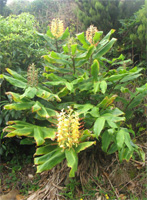 |
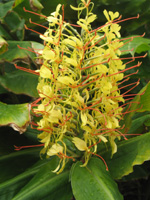 |
 |
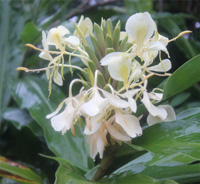 |
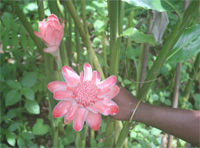 |
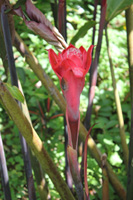 |
 |
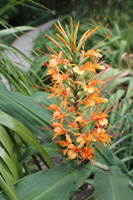 |
||
Spiced biscuits, gingerbread and other foods
Ginger is
used in many products. In Asia it was mainly in savory products, in the
Western world mainly
in
sweet products. Ginger is sold as stem ginger (ginger in
syrup of fresh water), ginger beer, as
the
soft drink ginger ale,
candied ginger (candied ginger candy) and pickled ginger (ginger pieces in
vinegar). In
Europe, it is mainly used in cakes and pastries,
such as gingerbread , ginger
cake and spiced biscuit.
Ginger
beer is from
the country
Suriname. In
Indonesia ginger is used in savory dishes such as babi
ketjap. In
Indonesia
ground ginger
is called
djahť. Ginger is also a component of curry blends.
Ginger and health
Ginger is
healthy for humans. Besides the culinary aspects ginger
has
a medicinal use. About ginger
there are much positive words in books and on the internet, but that's not
all confirmed by research. It can promote bowel movements, but it can also be
used to prevent vomiting and nausea in motion sickness. Furthermore, it should
also have a warming effect on the body,
it
stimulate blood circulation and
increase the libido. Gingerol , shogaol and zingibireen could act as
antioxidants in the body and thereby help protect against cancer.
In the
Botanical
Garden of Amsterdam,
you can find
various
species
of the ginger family in the educational greenhouse (Butterfly
greenhouse) and the Tropical greenhouse.
Literature
T.M.E. Branney
Hardy Gingers,
including Hedychium, Roscoea, and Zingiber
Timber Press
C. Kalkman
Planten voor dagelijks gebruik- Botanische achtergronden en toepassingen
KNNV
Stevens, P. F. (2001 onwards).
Angiosperm Phylogeny Website.
Version 9, June 2008
http://www.mobot.org/MOBOT/research/APweb/
Johan van der Perk
Siergembers- een
pittig ingerdient voor de tuin
http://perkgroen.nl/Artikel%20Siergembers.pdf
Gember- Wikipedia
http://nl.wikipedia.org/wiki/Gember
Gember gebruiken (Allerhande, AH), videofilmpje
http://www.youtube.com/watch?v=84ONmZakCEE
Gember op
Mijnreceptenboek.nl
http://www.mijnreceptenboek.nl/ingredienten/specerijen/gember.html
This page has been created on Saturday 28 December 2013.
![]()
For additions or reacti
ons, send me an e- mail:
| Terug naar (return to): | Return to: |
